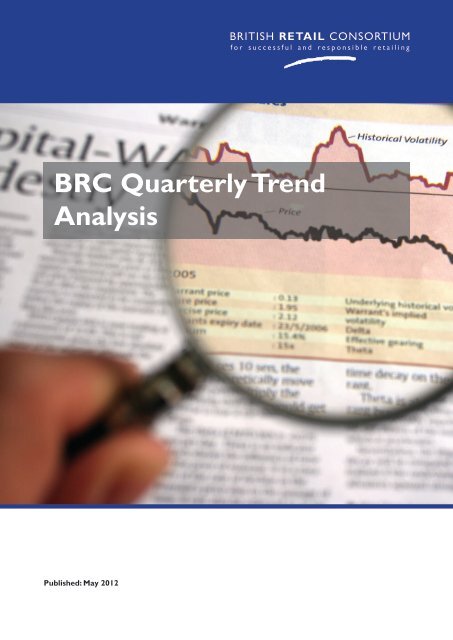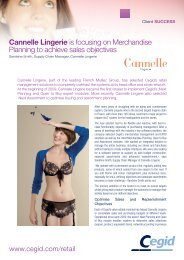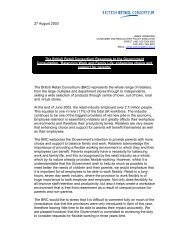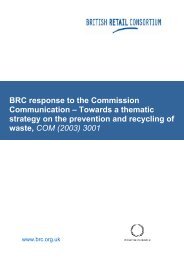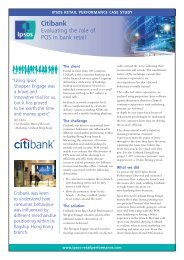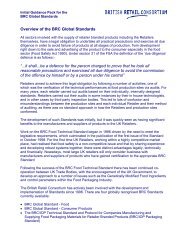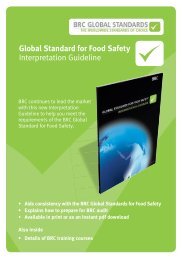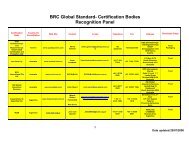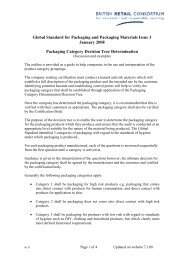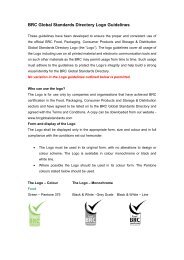BRC Quarterly Trend Analysis - British Retail Consortium
BRC Quarterly Trend Analysis - British Retail Consortium
BRC Quarterly Trend Analysis - British Retail Consortium
You also want an ePaper? Increase the reach of your titles
YUMPU automatically turns print PDFs into web optimized ePapers that Google loves.
Expanding UK, notexpanding overseasExpanding in UK andoverseasReducing/consolidatingUK, not expandingoverseasReducing/consolidatingUK, expandingoverseasN/AUK Exports (£m)200020012002200320042005200620072008200920102011<strong>BRC</strong> <strong>Quarterly</strong> <strong>Trend</strong> <strong>Analysis</strong>At the end of 2011, the deficit shrank to its lowestlevel since 2003. The UK’s export market hasbecome less dependent on the EU in recentyears (2007 – 58% v. 2011 – 53%) and there issome evidence to suggest firms have shifted theirfocus towards emerging markets where theoutlook for economic growth is much brighter andconsumer markets are booming.Real disposable income per personAverage % growth per annum, 2011-20219%8%7%6%5%4%3%2%1%0%1.4%1.0%Real disposable income is expected to average7.8% in China over the next 10 years, whileeconomies of India (6.5%) and Brazil (4.2%) arealso expected to show remarkable growth. Giventhe prospects for consumer spending in emergingmarkets, the rationale for UK investment islimited. Many large retailers are alreadybenefitting from an international presence,capturing considerable shares in these consumermarkets, and retailers’ investment intentions arefixed abroad for many.Source: Company Reports1.4%7.8%6.5%4.2%UK France Germany China India Brazil USSource : Oxford Economics<strong>Retail</strong>ers investment intentions 2011/12Number of retailers in our sample reporting that they were8765432101.8%Exports to non-EU countries have increased by73% over the past three years, compared to amuch smaller increase to EU countries of 20%.However, a considerable proportion of traderemains within the “core” European nations, manyof which are suffering from the economic turmoil.45,00040,00035,00030,00025,00020,00015,00010,0005,000Source: ONSUK Exports to selected markets0Although exports to emerging markets are risingfast they are doing so from a low base and sovolumes still remain relatively low, yet are movingin the “right” direction. In terms of trade, thebalance may get worse before it gets better giventhe crisis in the Eurozone, but economicindicators suggest that a more balanced economywill emerge.Given the prospects for consumer spending inemerging markets, the rationale for UKinvestment is limited. Many large retailers arealready benefitting from an internationalpresence, capturing considerable shares in theseconsumer markets.Consumer SpendingSpending patterns so far this year have beendifficult to distil in statistical terms. Seasonaldistortions and weather extremes have madeanalysing retail sales particularly tricky thisquarter. The hottest March on record saw a boostin retail sales which rose by 1.3% on a like-for-likebasis from March 2011, when they were down3.5% on a year ago. On a total basis, sales wereup 3.6%, against a 1.9% decline in March 2011.Food sales growth was unchanged from Februarybut non-food sales growth improved. March’sunusually warm sunny weather helped clothing,footwear and outdoor leisure. Indoor homewaresremained down on a year ago, with largerpurchases in particular hit by consumer caution.Online (including mail-order and phone) sales ofnon-food items showed stronger growth, butagainst a very weak March 2011. Sales were13.9% up on a year ago, the best sinceDecember 2011. The changing timing of Easteralways makes analysis difficult in March and April.GermanyItalySpainFranceChinaJapanUSA inc.Puerto Rica
<strong>BRC</strong> <strong>Quarterly</strong> <strong>Trend</strong> <strong>Analysis</strong>Easter fell in April 2011 but in March in 2010,meaning March last year looks exceptionallyweak.<strong>Retail</strong> Sales – food and non-foodSource: <strong>BRC</strong>In April, retail sales appeared much more testing.UK retail sales values were down 3.3% on a likefor-likebasis, when they were up 5.2% on a yearago. On a total basis, sales were down 1.0%,against a 6.9% increase in April 2011. Food salesfell back below their year-earlier level, when theyhad benefited from Easter buying. Record Aprilrainfall and chilly temperatures hit clothing andfootwear sales. Though it helped some smallerhomewares, big-ticket purchases continued tostruggle and were often promotion-led, amidcontinued consumer caution. Online (includingmail-order and phone) sales of non-food goodsshowed growth of 9.0% in April, against astronger 13.7% increase last year, but down fromMarch’s growth of 13.9%. While growth of onlinesales is showing signs of maturing, it remains thefastest growing channel in retail. Some retailerscommented that click-and-collect performed wellamong their multi-channel offering and the wetweather also helped to boost some online spend.Mobile-commerce also grew strongly but camefrom a very low base. However, underlyingconditions remain tough with sales promotiondriven,often at the expense of margins.Growth forecasts for consumer spending offerlittle hope for an imminent recovery. Consumerspending is expected to edge up only 0.4% thisyear, but this would recoup only a small portion oflast year’s 1.2% decline. However, predictions areeven more uncertain than usual, with Eurozonecountries continuing to cast a dark cloud.InflationThe Consumer Price Index (CPI) rose in March to3.5% driven by rises in food and clothing prices,but remains down on September’s peak of 5.2%.The drop reflected the effects of VAT dropping outof the 12 month comparison and earlier increasein energy prices. Core inflation, which excludesfood and energy, reported a rise, the first time infive months. Worryingly, inflation expectationsrose in April according to the survey by Citi andYouGov, with median expectations of inflationrising to 3.0% from 2.7% in March, the highestfigure since December 2011.The latest Bank of England Inflation Reportshowed an upward revision to inflation forecasts.Both the impact of higher energy prices andindirect taxes, and cost pressures from past risesin commodity prices are likely to have a greaterimpact on inflation in the near term thanpreviously anticipated. Overall, the gradualeasing of external price (commodities, importprices) pressures and weak demand shouldcause inflation to fall back.Although inflation is set to ease over the comingmonths, prices are “sticker” than many hadanticipated and so continue to outpace earnings.Real incomes continue to be squeezedLooking forward, it appears that there is little roomfor optimism for retailers, although it appears lastyear’s “perfect storm” for household finances –weak wage growth, high inflation and taxincreases, which combined to drive one of theworst annual declines in real disposable incomeson record, is slowly dispersing.The latest data showed that consumer spendingrose 0.4% quarter-on-quarter (q/q) in the fourthquarter of 2011, which was the first increase sincethe third quarter of 2010. This followedcontraction of 0.3% q/q in the third quarter of2011, 0.4% q/q in the second, and 0.8% q/q in thefirst. Overall, consumer spending contracted 1.2%in 2011 which reversed the increase of 1.2% in2010.Source: ONSAny rise in real earnings is unlikely to occurbefore the end of the year judging by the Bank ofEngland’s central forecast for CPI and the fragilityof the labour market. The recent rise in food
<strong>BRC</strong> <strong>Quarterly</strong> <strong>Trend</strong> <strong>Analysis</strong>inflation will not help spending in the short-termalthough much more modest levels of inflation areexpected towards the end of the year.However, falling inflation should ease thesqueeze on household budgets, helped by thebulk of austerity-driven tax rises behind us.The Shop Price Index (SPI) continued to showrestrained levels of inflation, particularly in nonfood,reflecting weakness in demand, thecompetitive nature of the sector and deepdiscounting.In April, the <strong>BRC</strong>-Nielsen Shop Price Index fell to1.3% from 1.5% in March. Food inflation fellsharply to 4.3%, while the non-food categoryreported deflation of 0.5%.<strong>BRC</strong>-Nielsen Shop Price IndexSource: <strong>BRC</strong>Non-food remained deflationary for the thirdconsecutive month in April. Clothing andfootwear, electricals and furniture all showeddeflation and so exerted considerable downwardpressure on the overall non-food index.Promotions remain a key driver of sales in thenon-food sector with the underlying environmentof weak consumer spending unchanged –particularly for discretionary purchases.Consumer spending may be hit even harder inthe coming months given the recent news that theUK economy has returned to recession. Althoughit was the production side of the economy, ratherthan services, that dragged it into recession, theimpact is likely to damage both business andconsumer confidence hard. The reality of retailerspassing on rising costs from business rates,distribution costs and from manufacturers remainsunlikely. This pincer movement of rising costsand promotion-driven demand is biting intomargins.Food inflation fell to 4.3% in March from 5.4% inApril. The sharp fall of 1.1 percentage pointshelped to slow the overall Shop Price Index (SPI).Downward pressure was exerted by both thefresh and ambient food categories, reporting asharp deceleration in their inflation rates. In freshfood, the oils and fats and fish categoriesreported a significant ease in their respectiveinflation rates, however, this was compared withdouble-digit inflation rates last year which affectedannual comparisons. Even so, the greatestdownward pressure came from alcoholicbeverages. Alcohol was impacted by March’sBudget and, like last year, was subject to anincrease in duty equivalent to a two per cent riseabove <strong>Retail</strong> Price Index (RPI) inflation. The lowerrate of RPI inflation this year softened the impacton the ambient food category.April’s food inflation figures are compared with asharp rise last year and so comparisons areagainst a rising base. Last year food inflationrose sharply, driven by elevated commodity pricesand so this should be taken into considerationwhen interpreting the annual figures.In the medium term, there are a number of risks inthe pipeline which could place upward pressureon food prices. Soyabeans, used in animal feedand as a source of oil in processed foods, hasmoved perilously close to the record high seen atthe end of June 2008, and has risen around 27%since January. Global production has fallen as aresult of hot and dry weather in Latin America,which accounts for over half of the world’s exportof the commodity. Demand from Chinese importshas grown 20% in the first quarter of the year,having a significant impact on supply. Robusteconomic growth in emerging markets continuesto improve living standards, pushing upconsumption and placing pressure on globalsupply chains. Corn supplies have also sufferedas a result. The United States Department forAgriculture (USDA) announced at the end of Aprilthe largest sale of corn on any one day for over20 years, China receiving the bulk of this export.While commodity prices look set to remain atelevated levels in the medium term, shocks incommodity prices take time to filter through thesupply chain to consumers.Consumer ConfidenceUnemployment, falling real incomes, the weakhousing market and uncertainty about theeconomic outlook have all hit consumerconfidence. The GfK NOP consumer confidencesurvey showed confidence remained steady inApril, noting that “much like the economy as awhole, consumer confidence is in the doldrums…with no signs either within the survey or in therecent economic figures to suggest anyimmediate improvement.” A stronger assessmentof the past year was offset by weakerexpectations for the year ahead, both on the
Jan-111.4%Q4 20091.6%Feb-110.9%Mar-11-0.8%Q1 20101.9%-0.2%Apr-11Q2 20103.6%-0.4%May-11Q3 20102.1%-0.7%Jun-110.3%Jul-11Q4 20100.6%Aug-110.5%Q1 20110.5%Sep-11-3.1%Q2 2011-0.4%Oct-110.6%Nov-11Q3 2011-0.8%0.7%Dec-110.4%Q4 20110.5%Jan-12-0.6%Q1 20120.4%Feb-120.6%Mar-12-1.3%<strong>BRC</strong> <strong>Quarterly</strong> <strong>Trend</strong> <strong>Analysis</strong>economic and job fronts. Overall confidence is stillmuch weaker than a year ago, averaging -31 overthe past six months, compared with -28 in theprevious six months and -26 a year ago.<strong>Quarterly</strong> change on previous yearGfK Consumer ConfidenceSource: <strong>BRC</strong>-Bond Pearce REMLabour MarketThe latest unemployment statistics from the Officefor National Statistics (ONS) showed a surprisedrop in the unemployment rate, falling to 8.3% inthe three months to February. The jobless totalfell by 35,000 to 2.65 million, the first quarterly fallsince May 2011. The claimant count rosemarginally by 3,600 to 1.61 million.Fewer shoppers out in the January salescompared with the previous year meant retailerscut back on overtime hours worked by retail staff.However, the number of FTE retail employeesrose in February (0.6%) and March (1.3%) asconditions improved for the sector andsupermarkets continued to open new stores andemploy more people. March’s rise in the numberof FTE retail employees was the strongest sinceJanuary 2011.The overall rise in the employment rate wasdriven by part-time workers, up by 80,000 on thequarter, while the number of full-time workers fellby 27,000 compared with the previous quarter. Asimilar trend was also seen in the <strong>Retail</strong>Employment Monitor (REM) which showed theoverall rate was driven by an uptake of part-timeworkers.Total <strong>Retail</strong>: Annual % growth in retailFTE employmentGrowth in average earnings continued to fallbehind the overall rate of inflation, demonstratingthe continued squeeze on real incomes. In thethree months to February, average earnings roseby just 1.1% for the whole economy while inflationedged up to 3.5% in March, rising three times asfast as wages.The latest data from the REM showed that retailemployment rose by 0.4% in the first quarter of2011 compared with the same period a yearearlier. This is the equivalent of 3,011 more FTEjobs according to our sample.January’s modest decline in the number of fulltimeequivalent staff of 0.6% reflects achallenging start to 2012 and followed news ofdeclining retail sales (like-for-like) and footfallreported earlier in the year.Source: <strong>BRC</strong>-Bond Pearce REMThe Monitor measured a significant improvementin retailers’ employment intentions during thesecond quarter of 2012. Only 8% of the samplesuggested that they would reduce staffing levelsduring the next three months compared with 29%in the same period a year earlier. One in five ofthe sample suggested that they intend to increasestaffing levels, the highest proportion at this timeof the year since the Monitor started in October2008. While underlying labour market conditionsremain challenging for many, there has been animprovement in sentiment.
<strong>BRC</strong> <strong>Quarterly</strong> <strong>Trend</strong> <strong>Analysis</strong>Gift Card and VoucherAssociationGrowth but not as we know it for aresilient but restrained vouchermarket in Q1 2012Like-for-like voucher sales grow moreslowly by 3.8% in Q1 2012Growth driven by business-to-businesssales, up by 5.7%; whilst consumer salesgrow marginally by 1.4% Agents sales continue upwards, by 19.5%this quarter; retailer sales remain flatBy Channel, corporate online sales andthird party sales show strongest growth,increasing by 60% and 37.5%respectively; consumer channels remainflatQ1 HighlightsBy category – Agents show strongest growth,whilst <strong>Retail</strong>er sales remain flatSales of vouchers by Agents continue toshow strong growth with sales up by19.5%. Corporate sales still represent thelion’s share of this type, but consumersales fought back this quarter, makinghealthy gains of 25%.<strong>Retail</strong>er sales of vouchers remained moreor less flat across both business-tobusinessand consumer sectors, in linewith the performance of the retail marketas a whole. Business to business salesdecreased by just under 1%; whilstconsumer sales lifted by just under 1%.Like-for-like sales of vouchers in theleisure category declined again in Q1 by3.3%, in line with the wider leisurecategory.By voucher type – Good growth for all typesof gift cards offset by sharp fall in papervoucher salesSales of Closed Loop gift cards increaseby 11.8%; as paper gift vouchers fall by12.2%Reported UK GVCA like-for-like voucher sales areup by 3.8% in Q1 2012, a more restrainedperformance compared to the dynamic growth ofprevious quarters. Even given these toughcomparisons, however, it may be the case thatthe voucher market starting to show some signsof wear and tear this quarter. Consumer vouchersales growth is modest, at just 1.4%, with salesthrough stores down by 1.7%. This is against awider retail market that more or less remained flatover the period, only managing a 0.3% increasein retail sales despite a boost from the sunshinein March, as reported by the <strong>BRC</strong>. Growth in thebusiness-to-business voucher market is still solid,but down to 5.7% year-on-year, indicating thatperhaps businesses are taking a cautiousapproach to the start of the year when it comes toinvesting in employee reward schemes.Closed Loop gift cards made gains of11.8% in Q1, with growth exclusivelycoming from the corporate sector.Consumer sales fell this quarter, year-onyear,by 4.9%, holding back higher growthoverall.The corporate sector continues to drivegrowth in Open Loop gift cards. Salesincreased by 20.5% like-for-like, stronggrowth but not quite at the same levels asin previous quarters.Sales of Paper vouchers declined by12.2% over the period, as corporatespending on this voucher type fell backsharply, down by 19%. Notably consumersales continued to grow by a healthy 15%- one of the few bright spots in theconsumer sector.Restricted Loop cards again recorded themost dynamic growth in Q1, with sales upby 66.7%. The corporate sector provided
<strong>BRC</strong> <strong>Quarterly</strong> <strong>Trend</strong> <strong>Analysis</strong>KPMG/IPSOS <strong>Retail</strong> Think TankHealth of UK retail will worsen torecord levelsFollowing its quarterly meeting in April 2012, theKPMG/Ipsos <strong>Retail</strong> Think Tank (RTT) – a panel ofretail industry commentators that providesauthoritative and independent views on issuesaffecting the sector – is reporting an even bleakeroutlook for UK retailers, with the health of theindustry expected to worsen to record levelsbefore any signs of recovery.Although high profile events such as The Queen’sDiamond Jubilee celebrations and 2012 Gameswill inject a ‘feel good’ factor for some, underlyingeconomic trends will have an increasinglydetrimental impact on consumer confidence andspending, according to the RTT.The RTT <strong>Retail</strong> Health Index is expected to fall toan all-time low of 77 by the end of quarter two of2012. This compares with 79 at the end of thefirst quarter and is five points lower than the levelrecorded during the depths of the original bankingcrisis and recession, in quarters two and three of2009.The deterioration in health in quarter one of 2012was not as significant as the RTT had originallyforecast, partly due to higher than anticipateddemand and margins pressures easing. Costsagain took their toll as retailers contended with anunexpected fuel crisis and higher energy prices,as well as ongoing investment in online and multichannelinfrastructure.Most worrying, the state of health by the end ofthe second quarter of 2012 looks set to be thebleakest on record since the RTT <strong>Retail</strong> HealthIndex was established. The combined effect ofincreased energy costs, raised fuel prices andhigher borrowing costs - among other economicand financial influences – is expected to furtherdampen consumer demand for in quarter two of2012. Although inflation is on the decline, it is stillabove wage rises and many consumers aredipping into their savings to keep up withincreasing pressures on their household budgetsand disposable income. The majority view of RTTmembers is that retailers will struggle evenfurther, although voting was split - reflecting thelevel of uncertainty that exists.Summarising the RTT’s April discussion, HelenDickinson of KPMG, said: “What we expected tohappen to the health of the UK retail sector in thefirst quarter looks to have been delayed until thesecond. The underlying economic and financialtrends are pointing in the wrong direction forretailers, many of whom are struggling togenerate sales, protect their margins and controltheir costs. The retail sector is undergoingstructural change as our desire to consume everincreasing volumes of goods diminishes andtechnological advances continue to change theway we shop. Future increases in selling pricesare not an option for retailers to use to help themrespond to these changes and maintain salesgrowth. Maintaining and improving profitability is agoal which is becoming harder and harder forretailers to achieve and hence the state of healthwill continue on a downward trajectory for theforeseeable future.”
<strong>BRC</strong> <strong>Quarterly</strong> <strong>Trend</strong> <strong>Analysis</strong>Contributors’ DetailsKPMGKPMG is the global network of professional servicesfirms whose aim is to turn understanding of information,industries and business trends into value. With nearly100,000 people worldwide, KPMG member firms provideassurance, tax and legal and financial advisory servicesfrom more than 750 cities in 150 countries.UK GIFT CARD & VOUCHER ASSOCIATION© <strong>British</strong> <strong>Retail</strong> <strong>Consortium</strong> 2012All rights reserved. No part of this publication may bereproduced in any form (including photocopying orstoring it in any medium by electronic means) without thepermission of the copyright owner.The articles and opinions contained in this publication donot necessarily reflect the views of the <strong>BRC</strong>. Whilst the<strong>BRC</strong> endeavour to ensure that the information in thispublication is accurate and that the articles containnothing prejudiced to the position or reputation of anyparty, the <strong>BRC</strong> shall not be liable for any damages(including without limitation, damage for loss of businessor loss of profits) arising in contract, tort or otherwisefrom its publication or any information contained in it, orfrom any action or decision taken as a result of readingthis publication.UK trade association the UKGCVA represents the keyplayers in the gift voucher, gift card and digital vouchermarket from high street retailers to gift voucher printersand gift card processors. www.ukgcva.co.ukKPMG/IPSOS <strong>Retail</strong> Think TankThe RTT was founded by KPMG and Ipsos <strong>Retail</strong>Performance (formerly Synovate) in February 2006. Itnow meets quarterly to provide authoritative ‘thoughtleadership’ on matters affecting the retail industry. Alloutputs are consensual and arrived at by simple majorityvote and moderated discussion. Quotes are individuallycredited. The <strong>Retail</strong> Think Tank has been createdbecause it is widely accepted that there are so manymixed messages from different data sources that it isdifficult to establish with any certainty the true health andstatus of the sector. The aim of the RTT is to provide theauthoritative, credible and most trusted window on whatis really happening in retail and to develop thoughtleadership on the key areas influencing the future ofretailing in the UK. Its executive members have beenrigorously selected from non-aligned disciplines tohighlight issues, propose solutions, learn from the past,signpost the road ahead and put retail into its rightfulcontext within the <strong>British</strong> social/economic matrix.
<strong>BRC</strong> <strong>Quarterly</strong> <strong>Trend</strong> <strong>Analysis</strong>Contact Details<strong>British</strong> <strong>Retail</strong> <strong>Consortium</strong>21 Dartmouth StreetWestminsterLondonSW1H 9BP020 7854 8900info@brc.org.ukRichard LimEconomist020 7854 8962richard.lim@brc.org.ukSiobhan BentleyBusiness Analyst020 854 8961Siobhan.bentley@brc.org.uk
www.brc.org.uk


